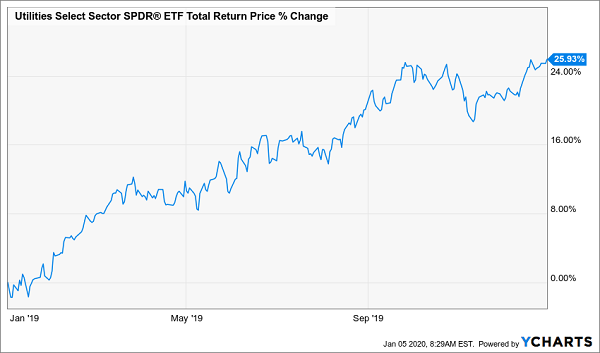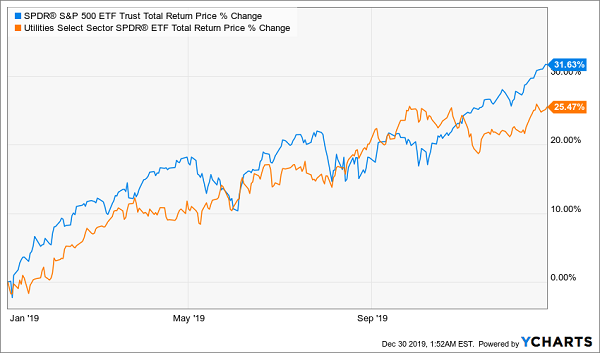What’s does 2020 hold for your utility stocks (and closed-end funds)? Will these steady income plays hand us another round of big gains and dividends? Or is there trouble ahead?
These are reasonable questions to ask after these “boring” stocks poured on a huge—and rather “un-utility-like”—26% total return last year:
Utilities or Exploding Small Caps? Tough to Tell.

Let’s dive into three critical factors that will tell the tale for utilities in 2020. And because it’s the season for forecasts, I’ll throw in my verdict on the sector for the coming year, too, and name five utility closed-end funds (CEFs) paying huge dividends of 6.3% to 9.4%.
2019’s Gain: Not What It Seems
First, bear in mind that 2019’s big return comes after a 2018 in which utility stocks did, well, very little, with a total return of just 3.9%. Strip out dividends and that drops to roughly zero:
Middling 2018 Fuels a Stellar 2019

With that in mind, 2019’s monster run doesn’t seem out of line: when we calculate utilities’ total returns over the last two years, we get an annualized 14.9%. That’s close to the 13.7% yearly average they’ve returned in the past decade, so there’s little worry of a correction here.
Let’s move on.
Utilities Were Actually Laggards in 2019
Another way to put utilities’ 2019 gain in perspective is to ask if they crushed other sectors and the S&P 500 as a whole.
They didn’t. Not by a longshot.
Utilities: “We’re No. 8!”

There’s a lot of small print in this chart, so let me break it down for you: on a price basis, utilities were eighth of the 11 S&P 500 sectors—far from outperformers! And even when you include their bigger-than-average dividends, utilities underperformed the S&P 500 as a whole and have mostly traded flat since mid-September:
Income Plays Do What They Should

In fact, as steady income producers, this kind of modest return relative to other sectors is what we’d expect, which is another argument against a major correction in 2020. However, utilities’ weakness in the past few months could set us up for a smaller downtick in the near term.
Finally, let’s talk about profits, the driving force behind our gains (and dividends).
2020 Earnings Look Strong—With a Catch
Here’s one spot where we see a yellow light, because utilities posted 8.3% earnings growth in 2019, tied with healthcare for top spot in the S&P 500.

As a result, expectations for 2020 are modest: just 5% profit growth, the lowest of all S&P 500 sectors (tied with financials). In short, the strong 2019 was great for last year, but it could set us up for a correction in the months ahead.
5 Utility CEFs for Your Watch List
While now may not be the best time to buy utilities, it is a great time to bulk up your watch list so you’re ready to pounce when a utility correction comes along. Here are five CEFs to add to yours now. All trade at discounts, and all boast S&P 500–busting yields of 6.3% to 9.4%.

4 Top CEF Buys for 2020: 20%+ Gains, 8.4% Dividends
Don’t worry—I’m not going to tell what you shouldn’t buy now and leave it at that! I think you’ll agree that’s a pretty unsatisfying way to end an investment article, especially when there are plenty of cheap 8%+ dividends out there.
Right now, for example, I’m pounding the table on 4 CEFs yielding an outsized 8.4%, on average. That’s far more than the utility funds mentioned above.
Another difference?
The 4 CEFs I’ll share with you right here are cheap now, relative to their historical average.
In fact, they’re trading at such wide discounts that I’m forecasting 20%+ price upside from each of these rock-solid picks in 2020. That’s in addition to their huge 8.4% dividends!
In other words, you could be looking at a 30% total return in just one year here!
And because you’re diversifying across 4 funds (which hold REITs, bonds, US and overseas stocks), you’re getting an extra margin of safety.
Now is the perfect time to buy these 4 income (and growth) stars. Get everything you need to know about these 4 bargain-priced 8.4%-paying CEFs—names, tickers, best buy prices and every shred of research I have—right here.
